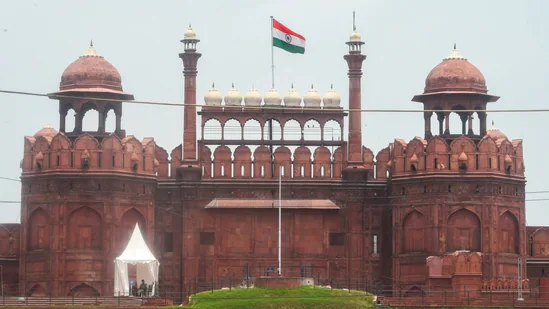10 Best Place To visit In Delhi

1. Red Fort, Delhi

The Red Fort, also known as Lal Qila, is a historic fort located in the city of Delhi, India. It was built by the Mughal Emperor Shah Jahan in the 17th century as the main residence for the Mughal emperors. The fort’s construction began in 1638 and was completed in 1648.
The Red Fort is named for its massive red sandstone walls, which surround the complex and stand as a symbol of Mughal architecture. The fort encompasses several significant structures, including the Diwan-i-Aam (Hall of Public Audience), where the emperor would address the public, and the Diwan-i-Khas (Hall of Private Audience), where the emperor would meet with important guests.
Another notable feature of the Red Fort is the iconic Lahori Gate, through which the prime minister of India hoists the national flag on Independence Day (15th of August) each year, marking India’s independence from British rule in 1947.
2.Qutub Minar

The Qutub Minar is a UNESCO World Heritage Site located in Delhi, India. It is one of the most famous landmarks in the city and is known for its architectural significance and historical importance.
Construction of the Qutub Minar began in 1193 by Qutb-ud-din Aibak, the founder of the Delhi Sultanate, and was completed by his successor, Iltutmish. The minaret is built of red sandstone and marble and stands approximately 73 meters (240 feet) tall, making it one of the tallest minarets in the world.
The Qutub Minar is adorned with intricate carvings and verses from the Quran, making it a remarkable example of Indo-Islamic architecture. It consists of five distinct stories, each marked by a projecting balcony. The lower three stories are built in a traditional Persian style, while the upper two stories exhibit a fusion of Persian and Indian architectural styles.
3.Jama Masjid, Delhi

Jama Masjid, also known as the Masjid-i Jahan-Numa (World-reflecting Mosque), is one of the largest and most renowned mosques in India. It is located in the heart of Old Delhi, near the iconic Red Fort. The construction of Jama Masjid was commissioned by the Mughal Emperor Shah Jahan and was completed in 1656 AD.
The mosque is constructed with red sandstone and white marble and is characterized by its vast courtyard, three grand entrance gates, and two towering minarets. The main prayer hall of the mosque can accommodate thousands of worshippers at a time.
Jama Masjid is renowned for its stunning architecture, featuring intricate marble inlays, carved arches, and delicate calligraphy inscriptions from the Quran. The central dome of the mosque is adorned with white marble stripes, which create a mesmerizing visual effect.
Apart from its architectural grandeur, Jama Masjid holds immense cultural and religious significance for Muslims in India. It remains an active place of worship and hosts large congregations, especially during important Islamic festivals such as Eid al-Fitr and Eid al-Adha.
4.Humayun Tomb, Delhi

Humayun’s Tomb is a magnificent mausoleum located in Delhi, India, and is one of the most significant examples of Mughal architecture. It was commissioned by Hamida Banu Begum, the wife of the Mughal Emperor Humayun, and construction began in 1565, nine years after Humayun’s death. The tomb was completed in 1572.
The tomb is situated in a large complex that also includes the graves of other members of the Mughal royal family. The architecture of Humayun’s Tomb is notable for its symmetrical design, incorporating Persian and Indian architectural styles. It features a large central dome surrounded by smaller domes, intricate marble lattice screens known as jalis, and ornate carvings.
The tomb stands in the center of a Charbagh, a traditional Persian-style garden divided into four quadrants by walkways and water channels. The garden is meticulously landscaped and adds to the grandeur of the mausoleum.
5.Akshardham Temple, Delhi

Akshardham Temple, also known as Swaminarayan Akshardham Temple, is a Hindu temple complex located in Delhi, India. It was inaugurated in 2005 and is one of the largest Hindu temples in the world.
The temple complex is dedicated to Bhagwan Swaminarayan and features a stunning blend of traditional Hindu architecture and modern technology. The central monument of the complex is the Akshardham Mandir, which is intricately carved from pink sandstone and white marble. It stands as a masterpiece of Indian craftsmanship, featuring sculptures, carvings, and ornate domes.
In addition to the main temple, the Akshardham complex includes several other attractions, such as:
- The Hall of Values (Sahaj Anand Water Show): An exhibition that showcases the values and teachings of Bhagwan Swaminarayan through interactive displays and multimedia presentations.
- The Boat Ride (Sanskruti Vihar): A boat ride that takes visitors on a journey through India’s rich cultural heritage, featuring animatronic figures, dioramas, and audio-visual effects.
- The Garden of India (Bharat Upavan): A landscaped garden that features sculptures depicting India’s contributions to the world in various fields, including science, art, and literature.

6.National Museums

National museums are institutions that preserve and showcase a country’s cultural, historical, scientific, and artistic heritage. These museums often hold extensive collections of artifacts, artworks, specimens, and other objects of historical or cultural significance. National museums play a crucial role in educating the public about their country’s heritage and fostering a sense of national identity and pride.
Many countries have multiple national museums dedicated to various aspects of their heritage, such as history, art, archaeology, natural history, science, technology, and anthropology. These museums often receive government funding and support, and they may be overseen by national cultural or educational authorities.
- The British Museum (United Kingdom): This museum in London houses a vast collection of art and artifacts from around the world, spanning thousands of years of human history and culture.
- The Louvre Museum (France): Located in Paris, the Louvre is one of the world’s largest and most visited art museums, known for its iconic glass pyramid entrance and extensive collection of art, including the Mona Lisa and the Venus de Milo.
- The Smithsonian Institution (United States): The Smithsonian is a group of museums and research centers in Washington, D.C., dedicated to various subjects, including art, history, science, and culture. It includes well-known museums such as the National Air and Space Museum and the National Museum of American History.
- The National Museum of China (China): Located in Beijing, this museum is one of the largest in the world and showcases China’s rich cultural and historical heritage through its extensive collection of artifacts, artworks, and archaeological findings..The National Museum of Anthropology (Mexico): Situated in Mexico City, this museum is dedicated to the anthropology and indigenous cultures of Mexico, featuring exhibits on pre-Columbian civilizations, ethnography, and contemporary indigenous cultures.
7.Lodhi Gardens

Lodhi Garden, also known as Lodhi Gardens, is a historical park located in New Delhi, India. It is spread over an area of approximately 90 acres and is a popular recreational spot and heritage site for locals and tourists alike.
Lodhi Garden is named after the Lodhi dynasty, which ruled over the Delhi Sultanate during the 15th century. The garden contains several architectural remnants from the Lodhi period, including tombs, mosques, and other structures.
One of the main attractions within Lodhi Garden is the Tomb of Sikandar Lodi, the second ruler of the Lodhi dynasty. Built in 1517, the tomb is an excellent example of Indo-Islamic architecture, featuring a prominent central dome and intricate stone carvings.
Another notable structure in the garden is the Shisha Gumbad, which translates to “Glass Dome.” It is believed to have been constructed during the 15th century and features decorative blue and green tiles on its exterior, giving it a distinctive appearance.
8.Chandni Chowk

Chandni Chowk is one of the oldest and busiest markets in Old Delhi, India. It was constructed in the 17th century by the Mughal Emperor Shah Jahan and remains a vibrant commercial hub today. Chandni Chowk is famous for its narrow lanes filled with shops selling a wide variety of goods, including textiles, jewelry, spices, street food, and more. It is also home to several historical landmarks, such as the Red Fort, Jama Masjid, and the Gurdwara Sis Ganj Sahib.
The Chandni Chowk is one of the oldest and busiest markets in Old Delhi, India. It is located close to the Old Delhi Railway Station. The Red Fort monument is located at the eastern end of Chandni Chowk. It was built in the 17th century by the Mughal Emperor of India, Shah Jahan, and designed by his daughter, Jahanara.
9.India Gate

The India Gate is a prominent war memorial located in the heart of New Delhi, India. It serves as a symbol of the sacrifices made by Indian soldiers during various wars, particularly World War I. The monument stands at the eastern end of Rajpath, a ceremonial boulevard in New Delhi, and is surrounded by lush lawns.
Designed by Sir Edwin Lutyens, the India Gate was inspired by the Arc de Triomphe in Paris and was completed in 1931. It is constructed of red sandstone and granite and stands at a height of 42 meters (138 feet). The archway of the monument bears the names of over 13,000 Indian and British soldiers who died in World War I, as well as in the Third Anglo-Afghan War.
The India Gate is also known for its eternal flame, known as the Amar Jawan Jyoti (Flame of the Immortal Soldier), which burns day and night as a tribute to the Indian soldiers who sacrificed their lives in the service of their country. The memorial is surrounded by lush lawns and serves as a popular gathering spot for locals and tourists alike, especially in the evenings.
10.Lotus Temple

The Lotus Temple, located in Delhi, India, is a renowned Bahá’í House of Worship. It is known for its distinctive lotus flower-shaped architecture, which has earned it the nickname “Lotus Temple.” The temple was completed in 1986 and serves as a spiritual gathering place for people of all religions and backgrounds.
Designed by Iranian-Canadian architect Fariborz Sahba, the Lotus Temple is composed of 27 free-standing marble-clad “petals” arranged in clusters of three to form nine sides, resembling the petals of a lotus flower. The structure is surrounded by nine reflecting pools, which further enhance its beauty and symbolism.







